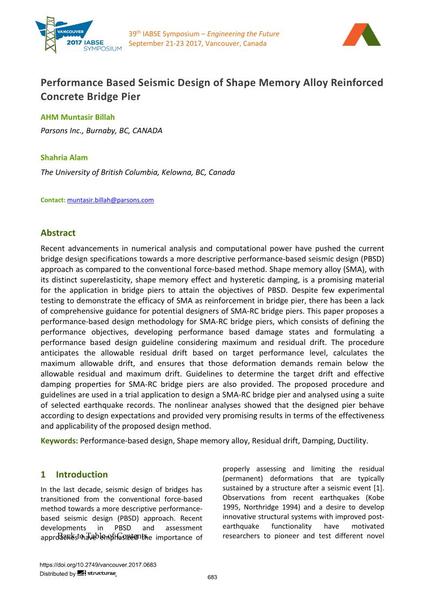Performance Based Seismic Design of Shape Memory Alloy Reinforced Concrete Bridge Pier

|
|
|||||||||||
Bibliographic Details
| Author(s): |
A. H. M. Muntasir Billah
(Parsons Inc., Burnaby, BC, CANADA)
Shahria Alam (The University of British Columbia, Kelowna, BC, Canada) |
||||
|---|---|---|---|---|---|
| Medium: | conference paper | ||||
| Language(s): | English | ||||
| Conference: | IABSE Symposium: Engineering the Future, Vancouver, Canada, 21-23 September 2017 | ||||
| Published in: | IABSE Symposium Vancouver 2017 | ||||
|
|||||
| Page(s): | 683-690 | ||||
| Total no. of pages: | 8 | ||||
| Year: | 2017 | ||||
| DOI: | 10.2749/vancouver.2017.0683 | ||||
| Abstract: |
Recent advancements in numerical analysis and computational power have pushed the current bridge design specifications towards a more descriptive performance-based seismic design (PBSD) approach as compared to the conventional force-based method. Shape memory alloy (SMA), with its distinct superelasticity, shape memory effect and hysteretic damping, is a promising material for the application in bridge piers to attain the objectives of PBSD. Despite few experimental testing to demonstrate the efficacy of SMA as reinforcement in bridge pier, there has been a lack of comprehensive guidance for potential designers of SMA-RC bridge piers. This paper proposes a performance-based design methodology for SMA-RC bridge piers, which consists of defining the performance objectives, developing performance based damage states and formulating a performance based design guideline considering maximum and residual drift. The procedure anticipates the allowable residual drift based on target performance level, calculates the maximum allowable drift, and ensures that those deformation demands remain below the allowable residual and maximum drift. Guidelines to determine the target drift and effective damping properties for SMA-RC bridge piers are also provided. The proposed procedure and guidelines are used in a trial application to design a SMA-RC bridge pier and analysed using a suite of selected earthquake records. The nonlinear analyses showed that the designed pier behave according to design expectations and provided very promising results in terms of the effectiveness and applicability of the proposed design method. |
||||
| Keywords: |
ductility performance-based design residual drift damping shape memory alloy
|
||||
